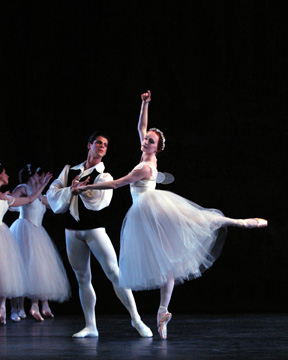Challenges and Rewards
American
Ballet Theatre
Les
Sylphides, Pillar of Fire, Theme and Variations
City Center
New York, NY
October 24, 2004, matinee
By
Mary Cargill
copyright
© 2004 by Mary Cargill
 After
last year’s “themed” programs, where one similar ballet
followed another, this program returned to the good old days of offering
an interesting variety of styles; a welcome challenge to both the dancers
and the audience. There is probably no better curtain raiser in all of
ballet than Fokine’s “Les Sylphides”. Once a staple
at ABT (Fokine himself set it), it has recently been in somewhat of a
legal limbo, controlled by the Fokine family, so it was especially welcome.
After
last year’s “themed” programs, where one similar ballet
followed another, this program returned to the good old days of offering
an interesting variety of styles; a welcome challenge to both the dancers
and the audience. There is probably no better curtain raiser in all of
ballet than Fokine’s “Les Sylphides”. Once a staple
at ABT (Fokine himself set it), it has recently been in somewhat of a
legal limbo, controlled by the Fokine family, so it was especially welcome.
For all of its obvious beauty, it is a very difficult ballet to do. It is a Russian classicist’s take on Romanticism, and style is everything. The performance was not completely successful, though the lugubrious tempos often heard seemed to have been refreshed, and the dancers did look like it was a good thing to be a sylph; too often “Les Sylphides” can seem an homage to Charles Addams.
Marcelo Gomes was the poet, and he was just about perfect. This production has slightly redesigned the costume—no floppy bow, just a flowing tie, and certainly no long blond wig. His dancing had a flow and a force—the movements seems to go from his body to his arms to space and he was able to create the sense of mysterious longing that is so essential to the piece; it was a beautiful performance.
His lead sylph, Gillian Murphy, was a bit hearty and four-square; she didn’t really have the mystery or the playfulness needed in the pas de deux, though of course her dancing was impeccable—she did the Mazurka, which suits her far better than the Prelude. Erica Cornejo’s Waltz had a glorious sense of urgency and delicate speed. Maria Riccetto danced the Prelude with a sweet playfulness, though there was also a slight brittleness.
The corps looked well-rehearsed, though they were a bit too stiff in the arms and torso. They could have rippled a bit more. But it is an absolutely beautiful work; I just hope it stays around a while.
Antony Tudor’s “Pillar of Fire”, too, returned last year after a long absence. It too, is a very difficult work, and it too, did not get a perfect performance. Michele Wiles, a young technical whiz kid, danced Hagar. So far, she has not been able to transcend her technique—I found myself watching her beautifully done steps, her lovely arabesque, her strong point work, rather than following the mood. She, and most of the other dancers, did not have the weight or the tension inside their bodies, and thus tended to look a bit overwrought and actressy. Monique Meunier’s Eldest Sister was an exception; every gesture made her narrow outlook, her fear of gossip, her conventionality very clear. Marian Butler’s Youngest Sister, too, was a real character, a selfish, heedless flirt, though she didn’t have the cruel streak that some dancers give the part.
Balanchine’s “Theme and Variations”, another long-time ABT staple, has a much more congenial style for ABT’s dancers, and the corps looked glorious, if a little cramped on that stage. Paloma Herrera, the lead ballerina, though, did not look entirely comfortable with the effortless majesty that the role calls for. She is immaculate from the waist down, but still has yet to control her arms; they just seemed decorative and frilly rather than expressive. Her partner, Angel Corella, was a joy, even if his turns came unstuck and wandered around the stage. There is, as with so many of the men at ABT, a real sense of presence, of being somebody on the stage, of communicating something far more than steps; it does seem at times that ABT is made up of men and girls.
Giliian Murphy and Marcelo Gomes in Les Sylphides. Photo: Marty Sohl.
www.danceviewtimes.com
Volume 2, No. 40
October 25, 2004
Copyright
©2004 by Mary Cargill
|
|
|